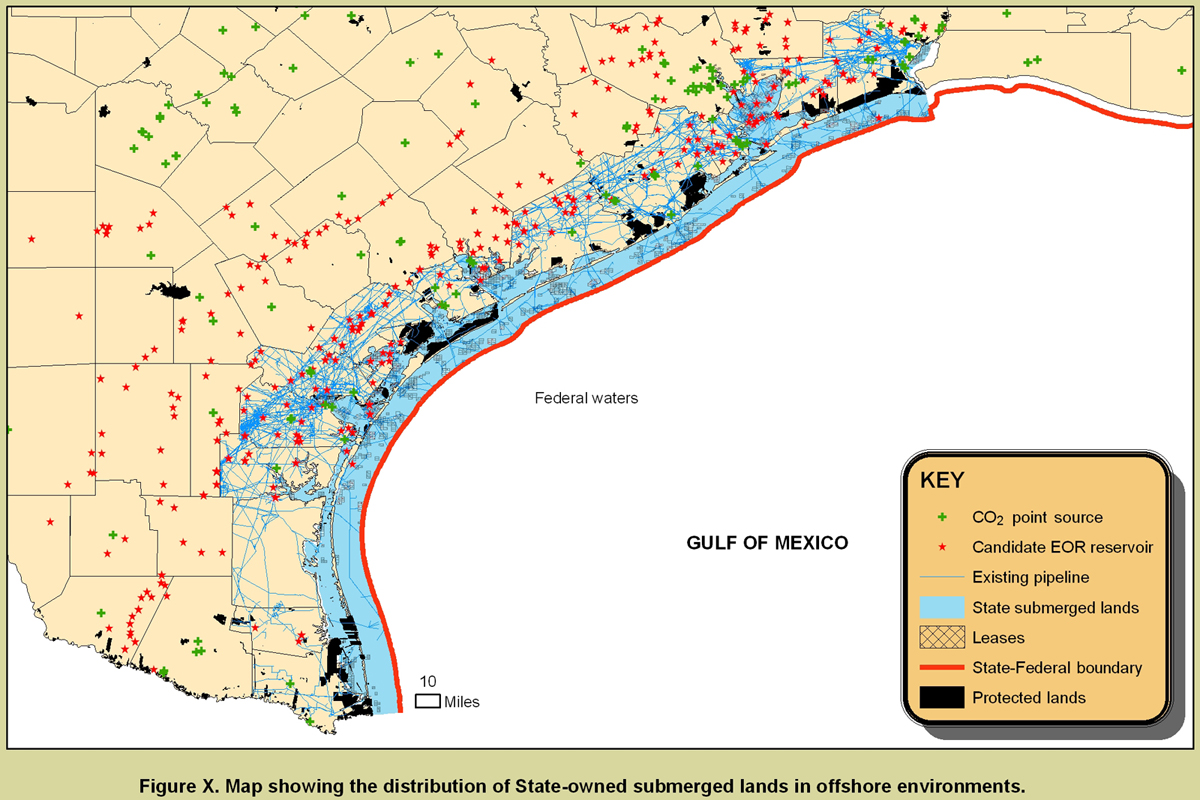Texas Passes Significant CCS Legislation
News Feature
July 21, 2009
In the spring of 2009, the 81st Texas Legislature passed landmark legislation to increase the options for Texas industries to reduce their carbon emissions through carbon capture and sequestration (CCS). CCS refers to the capture of atmospheric carbon and its sequestration in underground geological structures, thereby decreasing CO2 emissions to atmosphere. CCS is fundamental to plan for near-term or large volume reductions in emissions from point source (large stationary) carbon dioxide emitters. The legislation passed provides an important legal structure for developing federal policies that call for reduction of greenhouse gas emissions.
The action by the Texas Legislature sends a signal to industries that "the right rocks in the right place" to securely store the large volumes of CO2 that will be produced by current and future industry will be found in Texas. Finding the right rocks involves determining the geologically and environmentally appropriate location in which to sequester CO2. The right place refers to acquiring rights, permits, and pipelines to pore volumes in which carbon sequestration will occur.

Click on map to view larger.
House Bill 1796, sponsored by Representative Warren Chisum (and Senator Watson in the Senate), considers the possibility that "right place" is deep beneath the State-owned submerged lands off the Texas coast in the Gulf of Mexico. The State of Texas owns both the surface and subsurface of lands within 10.3 miles of the coast. The General Land Office administers these for the benefit of the Permanent School Fund, which partially supports Texas Public Schools. The sale of storage rights on these lands will serve not only industries and the environment, but benefit public education.
The submerged lands off the coast of Texas are made of thick sections of sandstones layered with shales. This type of geological formation has great potential to be the "right rocks" in which to sequester CO2. According to recent Gulf Coast Carbon Center (GCCC) studies based on the work of the UT Institute for Geophysics Gulf Basin Depositional Synthesis Project http://www.ig.utexas.edu/research/projects/gbds/gbds.htm these submerged lands likely have a very large capacity for CO2 storage. The new study will identify high value areas as well as risks to be avoided in developing a large-scale carbon repository in submerged lands in Texas.
This work is the first significant assessment of the suitability of submerged lands for CCS in the United States and puts Texas in position to take the lead in CCS in the U.S. as Norway has in the E.U. The GCCC hopes to attract federal funding to augment the state's investment.
Senate Bill 1387, sponsored by Senator Kel Seliger and crafted along with Representative Myra Crownover, addresses ownership issues with regard to onshore CCS. In particular, the bill provides preliminary jurisdiction over carbon sequestration in a reservoir that may be productive of oil or gas to the Railroad Commission. It also calls for a report by the General Land Office recommending a framework for management, monitoring, and verification of geologic storage of CO2 on state-owned lands in coordination with the Bureau of Economic Geology, the Railroad Commission, and the Texas Commission on Environmental Quality.
By providing sizeable tax incentives, House Bill 469 makes clear that legislators believe the right place for state-of-the-art CCS projects is Texas. Sponsored by Representative Phil King, this bill authorizes the Railroad Commission to issue up to three certificates for the construction of new clean energy projects. These certificates provide up to $100 million in franchise tax credits. The projects are required to capture and sequester 70 percent of the CO2 that they produce. The first three clean-coal projects built in Texas that meet the eligibility criteria in Texas House Bill 469 will be obligated to contract with the Bureau to develop the scientific standards and monitoring protocols for CO2 sequestration to ensure that 99 percent of the sequestered CO2 from the plant stays in the ground for 1,000 years. The BEG is a leader in the development of protocols for monitoring and looks forward to the opportunity to work on these important projects.
As a group, the three bills passed in the 81st legislative session set the stage for Texas to become a global leader in carbon capture and sequestration. The Legislature has shown that it intends to build the legal platform on which low carbon industries can develop.



